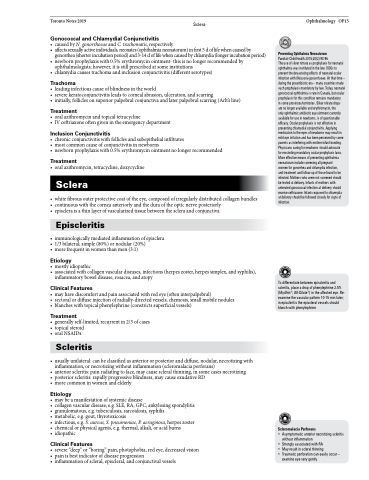Page 905 - TNFlipTest
P. 905
Toronto Notes 2019 Sclera
Gonococcal and Chlamydial Conjunctivitis
• causedbyN.gonorrhoeaeandC.trachomatis,respectively
• affectssexuallyactiveindividuals,neonates(ophthalmianeonatorum)infirst5doflifewhencausedby
gonorrhea (shorter incubation period) and 3-14 d of life when caused by chlamydia (longer incubation period)
• newbornprophylaxiswith0.5%erythromycinointment-thisisnolongerrecommendedby
ophthalmologists; however, it is still prescribed at some institutions
• chlamydia causes trachoma and inclusion conjunctivitis (different serotypes)
Trachoma
• leadinginfectiouscauseofblindnessintheworld
• severekeratoconjunctivitisleadstocornealabrasion,ulceration,andscarring
• initially,folliclesonsuperiorpalpebralconjunctivaandlaterpalpebralscarring(Arlt’sline)
Treatment
• oralazithromycinandtopicaltetracycline
• IV ceftriaxone often given in the emergency department
Inclusion Conjunctivitis
• chronicconjunctivitiswithfolliclesandsubepithelialinfiltrates
• mostcommoncauseofconjunctivitisinnewborns
• newbornprophylaxiswith0.5%erythromycinointmentnolongerrecommended
Treatment
• oral azithromycin, tetracycline, doxycycline
Sclera
• whitefibrousouterprotectivecoatoftheeye,composedofirregularlydistributedcollagenbundles • continuouswiththecorneaanteriorlyandtheduraoftheopticnerveposteriorly
• episcleraisathinlayerofvascularizedtissuebetweenthescleraandconjunctiva
Episcleritis
• immunologicallymediatedinflammationofepisclera • 1/3bilateral;simple(80%)ornodular(20%)
• morefrequentinwomenthanmen(3:1)
Etiology
• mostlyidiopathic
• associatedwithcollagenvasculardiseases,infections(herpeszoster,herpessimplex,andsyphilis),
inflammatory bowel disease, rosacea, and atopy
Clinical Features
• mayhavediscomfortandpainassociatedwithredeye(ofteninterpalpebral)
• sectoralordiffuseinjectionofradially-directedvessels,chemosis,smallmobilenodules • blancheswithtopicalphenylephrine(constrictssuperficialvessels)
Treatment
• generallyself-limited,recurrentin2/3ofcases • topicalsteroid
• oralNSAIDs
Scleritis
• usuallyunilateral:canbeclassifiedasanteriororposterioranddiffuse,nodular,necrotizingwith inflammation, or necrotizing without inflammation (scleromalacia perforans)
• anteriorscleritis:painradiatingtoface,maycausescleralthinning,insomecasesnecrotizing • posteriorscleritis:rapidlyprogressiveblindness,maycauseexudativeRD
• morecommoninwomenandelderly
Etiology
• maybeamanifestationofsystemicdisease
• collagenvasculardisease,e.g.SLE,RA,GPC,ankylosingspondylitis • granulomatous, e.g. tuberculosis, sarcoidosis, syphilis
• metabolic, e.g. gout, thyrotoxicosis
• infectious,e.g.S.aureus,S.pneumoniae,P.aeruginosa,herpeszoster • chemicalorphysicalagents,e.g.thermal,alkali,oracidburns
• idiopathic
Clinical Features
• severe“deep”or“boring”pain,photophobia,redeye,decreasedvision • painisbestindicatorofdiseaseprogression
• inflammationofscleral,episcleral,andconjunctivalvessels
Ophthalmology OP15
Preventing Ophthalmia Neonatorum
Paediatr Child Health 2015;20(2):93-96
The use of silver nitrate as prophylaxis for neonatal ophthalmia was instituted in the late 1800s to prevent the devastating effects of neonatal ocular infection with Neisseria gonorrhoeae. At that time – during the preantibiotic era – many countries made such prophylaxis mandatory by law. Today, neonatal gonococcal ophthalmia is rare in Canada, but ocular prophylaxis for this condition remains mandatory
in some provinces/territories. Silver nitrate drops are no longer available and erythromycin, the
only ophthalmic antibiotic eye ointment currently available for use in newborns, is of questionable efficacy. Ocular prophylaxis is not effective in preventing chlamydial conjunctivitis. Applying medication to the eyes of newborns may result in mild eye irritation and has been perceived by some parents as interfering with mother-infant bonding. Physicians caring for newborns should advocate
for rescinding mandatory ocular prophylaxis laws. More effective means of preventing ophthalmia neonatorum include screening all pregnant
women for gonorrhea and chlamydia infection,
and treatment and follow-up of those found to be infected. Mothers who were not screened should be tested at delivery. Infants of mothers with untreated gonococcal infection at delivery should receive ceftriaxone. Infants exposed to chlamydia at delivery should be followed closely for signs of infection.
To differentiate between episcleritis and scleritis, place a drop of phenylephrine 2.5% (Mydfrin®; AK-Dilate®) in the affected eye. Re- examine the vascular pattern 10-15 min later; in episcleritis the episcleral vessels should blanch with phenylephrine
Scleromalacia Perforans
• Asymptomatic anterior necrotizing scleritis without inflammation
• Strongly associated with RA
• May result in scleral thinning
• Traumatic perforation can easily occur –
examine eye very gently


